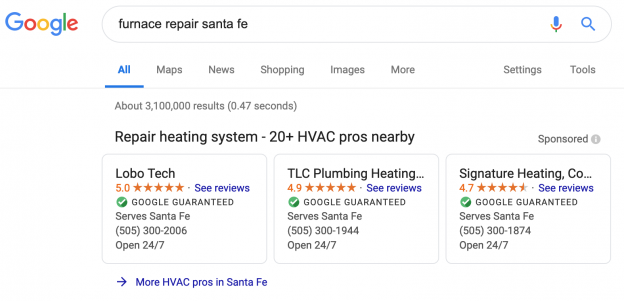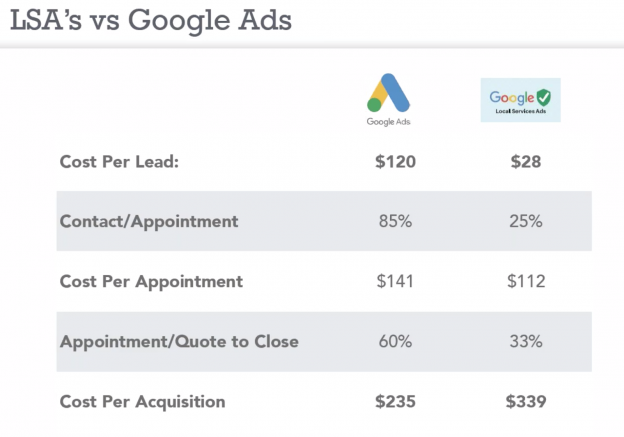
About this time last year, we did a deep dive into the rollout of Google’s brand new paid search product, Local Services Ads (LSAs) and how it would affect the home performance and HVAC industries. After LSAs were available in enough major markets, we took a closer look at how they were actually working in Local Services Ads, Part 1.
Now that some time has passed with LSAs, we have been able to gather real world data (see: our most recent webinar) on this new product and see how it can effectively factor into your digital marketing efforts.
The Stuff That Hasn’t Changed
LSAs are still a paid product that shows up in the prime spot of search engine result pages (SERPs). It affects most HVAC and home performance categories — so when someone searches for a service in a city where LSAs are available (e.g., “furnace repair in Santa Fe, NM”) the searcher is given a carousel list of three contractors, with their contact info, a “Google Guarantee” badge, and their cumulative Google review status. It looks like this:

LSAs are the first thing a searcher, or potential lead, will see in an area where LSAs are available. This prime real estate is why you pay for a service like LSAs.
LSAs are the first thing a searcher, or potential lead, will see in an area where LSAs are available. This prime real estate is why you pay for a service like LSAs.
LSAs are still at the very tippy-top, above all other organic results, the Local Pack, and any other Pay Per Click ads (PPC). There is still a “Google Guarantee," and your own company or brand guarantee is still probably much better. LSAs are still occupying only three spots, and those three spots are ranked based on the following:
-
Location (There’s not much to be done here; it is what it is.)
-
Review score (This includes all reviews, but especially those from customers who reviewed your business after finding you through an LSA.)
-
GMB responsiveness
-
Business hours
-
Any existing complaints to Google about your business
Categories have expanded to include thermostat installation (which we can assume is a byproduct of Google’s relationship with Nest — search volume for “Nest Thermostat installation” is over 87x that of just “thermostat installation service.”) All leads that come in through LSAs are managed through an app. When a lead comes in, you get a phone number, the category they searched for, if that lead click has been charged to your account, and sometimes (we’re not sure what determines this) the service they are looking for. You will not receive a name for any of your LSA leads.
The Stuff That Has Changed (Our Minds)
Google began testing LSAs in 2016, and we started seeing the rollout in 2018. Now that they have been operating for nearly a year, not much has changed as far as the look and feel of LSAs. What has changed and evolved is how we recommend you use them.
Initially, the primo real estate that these ads took up showed potential to be a game changer for paid search ads. A lot of our clients were both excited and anxious to get in early and capture as much paid local search as possible. However, the quality of these leads and their related lead economics aren’t having much of a blockbuster effect, and it seems the honeymoon is over.
LSAs Devour PPC
This is a textbook example of how Google has set themselves up to win. LSAs have pushed Google Ads (PPC ads) further down the page — sometimes they appear between the local pack and LSAs, sometimes they are pushed down below both — but this just means Google now has two products for searchers to sift through before any organic results. LSAs are having a continued effect on impressions and clicks, as expected:
6 Months: New LSA Market
-
Impressions are down 44%
-
Clicks are down 67%
-
Average CPC is up 3%
12 Months: Mature LSA Market
-
Impressions are down 59%
-
Clicks are down 62%
-
Average CPC is up 18%
Cost Per Lead
The cost per lead has averaged out to be $28 for the HVAC industry. From what we are hearing, the chance that you will actually talk to a customer who has submitted a lead is around 25%. So the “real” cost per qualified lead is about $112.
From those qualified leads, we are seeing a close rate of 33%. So, when you follow the money all the way through to a completed job, each LSA acquisition is costing $339. Of course, whether or not these numbers will work for you will depend on your business; but if we use the 7% Customer Acquisition Cost rule of thumb, you will need to be booking jobs with an invoiced value of $4,843.
When compared to Google Ads, we are seeing that a solid PPC strategy is providing higher quality leads as well as higher contact/appointment rates:

The higher contact/appointment rate of Google Ads could be an indicator that LSAs are not producing the qualified leads we were expecting this time last year.
The higher contact/appointment rate of Google Ads could be an indicator that LSAs are not producing the qualified leads we were expecting this time last year.
The Future of LSAs: A Great Addition to PPC
So what does this mean for your digital marketing strategy moving forward? Our recommendation is to utilize LSAs and PPC together. Google Ads have a few advantages over LSAs, and proximity is a big one. Google Ads have the potential to overcome an LSA proximity bias, and with a properly managed PPC keyword strategy, your ads will show up for a much wider range of searches than an LSA will. But keep an eye on it — if your PPC ads are consistently showing up directly underneath your LSAs, LSAs may not be worth the extra cost.
In other words, a Google Ad PPC strategy is probably a better use of your budget, but a good PPC plan can be supplemented with LSAs. And from what we can tell, the reverse does not seem to yield the same results.